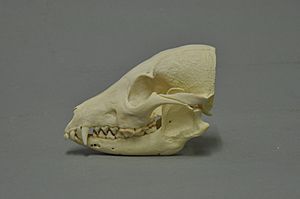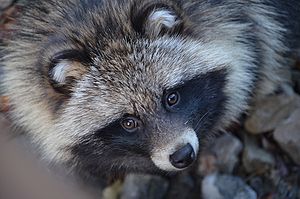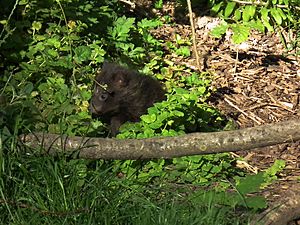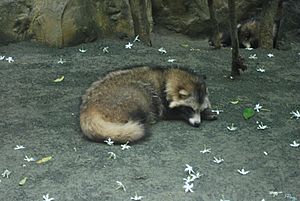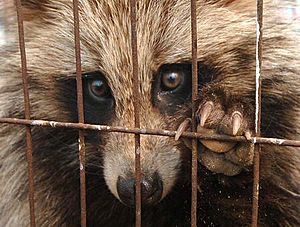Raccoon dog facts for kids
Quick facts for kids Raccoon dog |
|
|---|---|
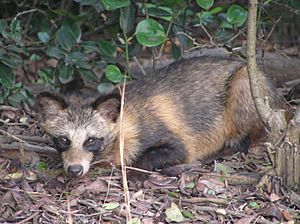 |
|
| N. procyonoides in Shiraishijima, Japan. | |
| Conservation status | |
| Scientific classification | |
| Genus: |
Nyctereutes
|
| Species: |
procyonoides
|
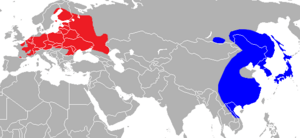 |
|
| Raccoon dog range Blue – native area Red – area of introduction |
|
The raccoon dog is a fascinating animal. It is also known as the mangut, tanuki, or neoguri. This animal is a type of dog family member. It lives naturally in East Asia.
Even though it's called a "raccoon dog," it's not closely related to the American raccoon. Instead, its closest relatives are true foxes. The raccoon dog gets its name because its face looks a lot like a raccoon's face.
Raccoon dogs are special among dog family members. They are one of the few canids that regularly climb trees. The only other one is the North American gray fox. In Japan, the raccoon dog, called tanuki, is famous in old stories. In some European countries, like Sweden and Denmark, it is seen as an invasive species. This means it can cause problems for local animals.
Contents
Description
Raccoon dogs have skulls that look a bit like those of South American foxes. However, studies show they are not closely related. Their skulls are small but strong. They have narrow zygomatic arches, which are bones near the cheeks.
Because they eat many different foods, raccoon dogs have small, weak canine teeth. Their other teeth are flat, good for grinding. They also have long intestines. Their bodies are long, and their legs are short. Raccoon dogs can be about 45 to 71 centimeters (18 to 28 inches) long. Their tails are short, only about 12 to 18 centimeters (4.7 to 7.1 inches) long. Their ears are also short and don't stick out much from their fur.
Their weight changes with the seasons. In March, they might weigh about 3 kilograms (6.6 pounds). But by late summer, males can weigh 6.5 to 7 kilograms (14 to 15 pounds). Some can even reach 9 to 10 kilograms (20 to 22 pounds). Raccoon dogs from Japan and Russia are usually bigger than those from China.
In winter, their fur is long and thick. It has a dense undercoat and coarse guard hairs. This fur helps them stay warm in very cold temperatures, even down to −20° to −25°C (−4° to −13°F). Their winter fur is a dirty, earthy brown or brownish-grey color. They have black guard hairs. The tail is darker than the body. A dark stripe runs along their back, widening at the shoulders to form a cross shape. Their belly is yellowish-brown, and their chest is dark brown or black. Their face has short hair, which gets longer around their eyes. Their cheeks have long, whisker-like hairs. In summer, their fur is lighter and reddish straw-colored.
Sometimes, a rare white raccoon dog is born in Japan and China. Raccoon dogs share some traits with other small carnivores. Their fur color, especially the mask on their face, looks like a raccoon's. They are mostly active at night, but they can change their schedule. This depends on where they can find food.
Ecology
Diet
Raccoon dogs are omnivores, meaning they eat both plants and animals. Their diet includes:
- insects
- rodents
- amphibians (like frogs and toads)
- birds and their eggs
- fish
- reptiles (like young tortoises and their eggs)
- mollusks
- carrion (dead animals)
- insectivores (like shrews and hedgehogs)
They also eat many plant foods. These include fruits, nuts, and berries. They might eat bulbs, rhizomes, oats, millets, and maize. They also enjoy grapes, melons, watermelons, pumpkins, and tomatoes. In Japan, they even climb trees to find fruits and berries.
Raccoon dogs change what they eat depending on the season. In late autumn and winter, they mostly eat rodents and dead animals. In spring, they prefer fruits, insects, and amphibians. In summer, they eat fewer rodents. They focus more on nesting birds, fruits, grains, and vegetables.
Predators
Wolves are the main predators of raccoon dogs. They kill many raccoon dogs, especially in spring and summer. Red foxes also kill raccoon dog pups. They have even been known to kill adult raccoon dogs.
Both foxes and Eurasian badgers compete with raccoon dogs for food. They might kill raccoon dogs if they enter their burrows. Eurasian lynxes rarely attack them. Large birds of prey also hunt raccoon dogs. These include golden eagles, white-tailed eagles, goshawks, and eagle owls.
Behavior
Reproduction and life cycle
The mating season for raccoon dogs starts in early February and lasts until late April. This depends on where they live. Raccoon dogs are monogamous, meaning they usually stay with one partner. Pairs often form in the autumn.
The pregnancy lasts about 61 to 70 days. Pups are born in April or May. A mother usually has 6 to 8 pups. In special cases, she might have 15 or 16 pups. First-time mothers usually have fewer pups. Male raccoon dogs help a lot in raising the pups. This help is very important for the pups to survive.
When pups are born, they weigh 60 to 110 grams (2.1 to 3.9 ounces). They are blind and covered in soft, dense fur. Their eyes open after 9 to 10 days. Their teeth start to grow after 14 to 16 days. Guard hairs, which are longer, coarser hairs, start to grow after 10 days. After two weeks, their fur gets lighter, but they still have black fur around their eyes.
Mothers feed their pups milk for 45 to 60 days. However, pups start eating other food that their parents bring them when they are only three weeks to one month old. They reach their full size at about 4.5 months. Pups leave their parents in late August or September. By October, the pups look like adults and start to form pairs. They can have their own pups when they are 8 to 10 months old. In the wild, raccoon dogs can live for 6 to 7 years. In zoos, they have been known to live for 11 years.
Hibernation
Raccoon dogs are the only members of the dog family known to hibernate. In early winter, they gain a lot of fat. This fat helps them survive the cold months. If they don't gain enough fat, they usually don't survive the winter. During hibernation, their body slows down by 25%.
In some areas, like Primorsky Krai, raccoon dogs only hibernate during very heavy snowstorms. In December, when snow is deep, they stay close to their burrows. Their activity increases in February when females are ready to mate and food becomes more available.
Vocalizations
Unlike many dogs, raccoon dogs do not bark. Instead, they make a growling sound, followed by a long, sad whine. Raccoon dogs in captivity have been heard to make a different sound when they are hungry. This sound is like a soft meow. Males fighting over females might yelp and growl. Japanese raccoon dogs make sounds that are higher pitched than domestic dogs. Their sounds can sometimes sound like cats.
Expanded range and invasive species
Between 1928 and 1958, about 10,000 raccoon dogs were brought to 76 different areas in the Soviet Union. This was done to improve the quality of their fur. The first place they were introduced was Primorsky Krai in the Russian Far East.
Raccoon dogs did not do well in some areas, like Irkutsk and Altai. This was because of harsh winters and not enough food. They also struggled in the mountains of the Caucasus and Central Asia. However, they did very well in the Baltic states and many parts of European Russia.
In 1948, 35 raccoon dogs were brought to Latvia. Their population grew very quickly. By 1960, Latvia reported that over 4,210 raccoon dogs were hunted.
Today, the raccoon dog is common in Estonia, Finland, Latvia, and Lithuania. They have also been seen in many other European countries. These include Bulgaria, Serbia, France, Poland, Germany, and Sweden. Because they spread so much, some countries are trying to control their numbers. For example, Denmark aimed to have no breeding raccoon dogs by 2015. However, by 2018, they were fully established in Jutland, Denmark.
Relationships with humans
Game and crop damage
Raccoon dogs can harm populations of game birds. This is especially true in floodlands and near water. Here, they mostly eat eggs and chicks in the spring. Birds can make up a large part of their diet in some areas. They also harm the muskrat trade by destroying nests and eating young muskrats. In Ukraine, raccoon dogs can damage kitchen gardens, melon farms, vineyards, and corn fields.
Hunting
Raccoon dogs are usually hunted from November until the snow gets too deep. In the Far East, people hunt them at night with dogs. In the 19th century, some native people put bells on their hunting dogs' collars. In Europe, raccoon dogs are often caught by accident when people are hunting other animals. Hunting with dogs is the most effective way to catch them. Traps are often set near their burrows or by water.
Many raccoon dogs are hunted each year. In Finland, 60,000 to 70,000 were hunted in 2000. This number increased to 170,000 in 2009. In Japan, between 18,000 and 70,000 Japanese raccoon dogs were killed from after WWII until 1982. Japan increased its hunting of raccoon dogs in the 1970s.
Fur use
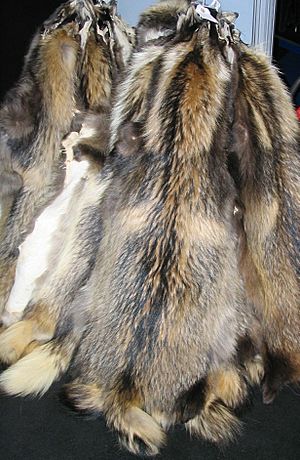
The fur of the raccoon dog is often called "murmansky" or "tanuki" fur when used for clothing. In the United States, it's called "Asiatic raccoon." In Northern Europe, it's known as "Finn raccoon." The best quality fur is silky, with guard hairs that stand up straight. Small, silky pelts are worth more than large, coarse ones.
Because their fur has long, coarse guard hairs and woolly fibers that can tangle, raccoon dog pelts are mostly used for fur trimmings on clothes. Japanese raccoon dog pelts are the most valuable, even though they are smaller. Pelts from Amur and Heilongjiang are also highly valued. Korean and southern Chinese pelts are less valued. Raccoon dogs raised in captivity can produce wool similar to goat wool.
In Japan, native people used raccoon dog skin for various things. They made bellows, decorated drums, and created winter hats. The trade of raccoon dog pelts was active in Russia in the 1880s. In the early 1900s, the world trade of raccoon dog pelts was very large.
Folklore
In Japanese stories, the raccoon dog, or Tanuki, is known for its ability to change shape. It is often seen as a playful trickster. Other animals like the fox and the badger are also known as shapeshifters in Japanese folklore.
Images for kids
See also
 In Spanish: Nyctereutes para niños
In Spanish: Nyctereutes para niños



